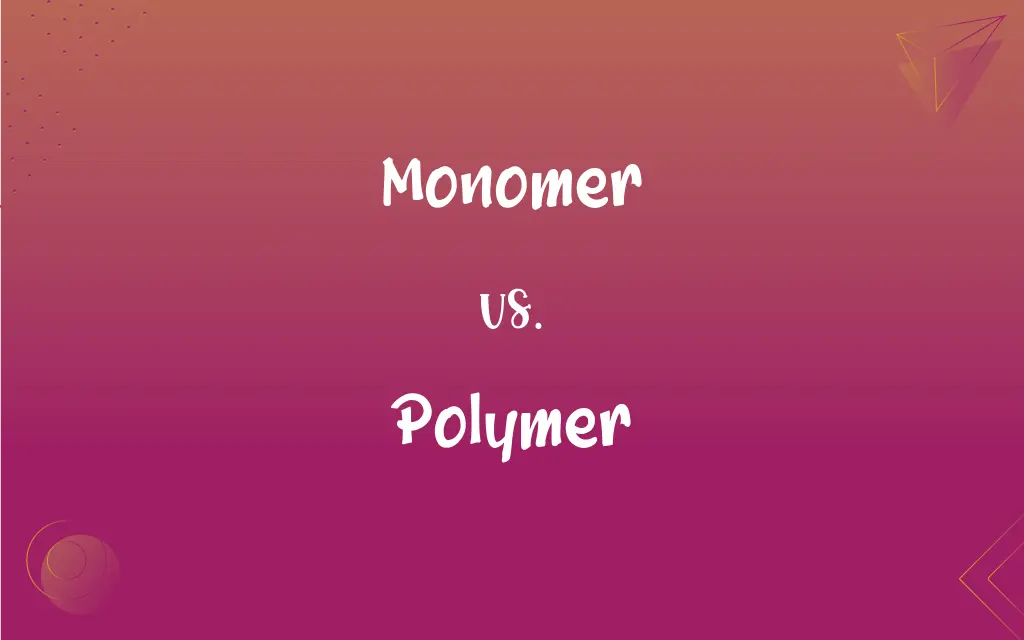Monomer vs. Polymer: What's the Difference?
Edited by Janet White || By Harlon Moss || Updated on October 13, 2023
A monomer is a single molecular unit that can bind to other units, while a polymer is a large molecule made up of repeated monomer units.

Key Differences
A monomer, deriving its name from the Greek words "mono" meaning one and "meros" meaning part, denotes a single molecular entity. Its primary function is to serve as a building block in the creation of larger structures known as polymers. Conversely, a polymer, sourced from the Greek “poly” meaning many, implies a larger, often chain-like structure composed of numerous monomer units. Thus, the fundamental difference lies in the quantity and structural complexity of the two, with monomers being singular and basic, while polymers are complex and multi-unit entities.
Monomers act as fundamental components in the realm of polymer chemistry, primarily due to their capacity to form covalent bonds with other monomers, subsequently generating polymers. This process is known as polymerization, where monomers are covalently bonded, forming larger molecular structures, or polymers, which might manifest in various forms, such as linear or branched configurations, depending on the bonding mannerisms of the monomers involved. Thus, while monomers represent simplicity and singularity, polymers illustrate complexity and multiplicity, both inherently connected through chemical bonding pathways.
In practical applications, monomers, such as ethylene and propylene, are used to synthesize polymers which subsequently find utility in myriad ways, such as in the creation of plastics, rubbers, and fibers. Therefore, monomers and polymers alike become integral to various industries, such as automotive, textile, and packaging. Monomers provide the essential foundational units, while polymers offer varied practical applications, thereby making both indispensable in diverse industrial domains.
Further, monomers can exist independently and often do in various natural and synthetic contexts. Polymers, meanwhile, owing to their size and structure, may exhibit different physical properties, such as elasticity, durability, and resistance to certain chemicals. The dichotomy between monomers and polymers is pivotal in understanding their respective functionalities; with monomers acting as the essential precursors and polymers as the resultant, functional entities in various applications.
When viewing them from a biological perspective, monomers like nucleotides, amino acids, and glucose form naturally occurring polymers—DNA, proteins, and starch, respectively. Here, monomers serve as vital constituents in biological pathways, while polymers play crucial roles in structural and functional biology, signifying the intrinsic importance of both monomers and polymers in sustaining life.
ADVERTISEMENT
Comparison Chart
Definition
A single molecular unit.
Molecules formed from repeated monomer units.
Size
Small molecular size.
Large molecular size.
Occurrence
Can exist independently.
Cannot exist without monomers.
Complexity
Simple structure.
Complex, often chain-like structure.
Example
Ethylene
Polyethylene
ADVERTISEMENT
Monomer and Polymer Definitions
Monomer
A monomer is a molecule that can combine with others to form a polymer.
Ethylene, a hydrocarbon monomer, is used to create polyethylene.
Polymer
A polymer is a substance composed of large molecules formed from monomers.
Polyethylene, a common polymer, is used in plastic bags.
Monomer
Monomers act as foundational building blocks in polymer chemistry.
The monomer, propylene, is critical in synthesizing polypropylene.
Polymer
Polymers can be synthetic, like plastics, or naturally occurring, like DNA or proteins.
DNA is a biopolymer that encodes genetic information.
Monomer
Monomers possess the ability to bind covalently to identical or different monomers.
Vinyl chloride monomer is vital for manufacturing PVC plastic.
Polymer
Polymers can exhibit diverse structural forms, such as linear or branched arrangements.
Polyvinyl chloride, a versatile polymer, is used in various construction materials.
Monomer
Monomers in biology include entities like amino acids and nucleotides.
Adenine, a nucleotide monomer, is essential in forming DNA.
Polymer
Polymers exhibit varied properties like elasticity, durability, and resistance based on their composition.
Rubber, a natural polymer, is renowned for its elasticity.
Monomer
Monomers exhibit relatively straightforward structural configurations.
The monomer styrene is utilized to create the polymer polystyrene.
Polymer
Polymers can undergo various physical and chemical processes to alter their properties.
Polyethylene terephthalate, a type of polymer, is recycled to make new plastic products.
Monomer
A molecule that can combine with other molecules to form a polymer.
Polymer
Any of numerous natural and synthetic compounds of usually high molecular weight consisting of up to millions of repeated linked units, each a relatively light and simple molecule.
Monomer
(chemistry) A relatively small molecule which can be covalently bonded to other monomers to form a polymer.
Polymer
(organic chemistry) A long or larger molecule consisting of a chain or network of many repeating units, formed by chemically bonding together many identical or similar small molecules called monomers. A polymer is formed by polymerization, the joining of many monomer molecules.
Monomer
The basic conceptual building unit of a polymer; a molecule of low molecular weight which may combine with other molecules to form a molecule in a chain or branched form having high molecular weight; as, amino acids are the monomer units which are combined to form proteins; vinylic plastics are formed from monomers having a vinyl group.
Polymer
A material consisting of such polymer molecules.
Monomer
A simple compound whose molecules can join together to form polymers
Polymer
Any one of two or more substances related to each other by polymerism; specifically, a substance produced from another substance by chemical polymerization.
Polymer
A naturally occurring or synthetic compound consisting of large molecules made up of a linked series of repeated simple monomers
FAQs
What is a monomer?
A monomer is a molecule that can bind with other identical molecules to form a polymer.
What defines a polymer?
A polymer is a large molecule comprised of repeating subunits, or monomers.
Can monomers exist independently?
Yes, monomers can exist as independent molecules.
How does polymerization of monomers occur?
Polymerization often occurs via addition (chain-growth) or condensation (step-growth) mechanisms.
What is a polymer chain?
A polymer chain is a series of monomer units covalently bonded in a linear fashion.
How are polymers formed from monomers?
Polymers are formed from monomers through a process called polymerization.
Can a polymer be broken down into its monomer units?
Yes, through processes like hydrolysis, polymers can be broken down into monomers.
Can monomers be synthesized in a lab?
Yes, monomers like ethylene and propylene can be synthesized.
How do polymers exhibit different physical properties?
Polymers exhibit varied properties like flexibility or rigidity depending on their molecular structure.
Can a polymer consist of different types of monomers?
Yes, a copolymer is formed when two different types of monomers are involved in polymerization.
Are all plastics polymers?
Yes, all plastics are polymers but not all polymers are plastics.
What role do monomers play in polymer properties?
The type of monomers and how they're arranged influence the properties and functions of the polymer.
Are proteins considered polymers?
Yes, proteins, made of amino acid monomers, are considered polymers.
Can polymers be found in nature?
Yes, natural polymers like DNA, cellulose, and proteins are found in nature.
What is a common synthetic polymer?
A common synthetic polymer is polyethylene, used in many plastic products.
What is the significance of monomers in biology?
In biology, monomers like nucleotides and amino acids form essential polymers like DNA and proteins.
What’s a practical application of a polymer?
Polymers like polypropylene are used in packaging, textiles, and various products.
What are elastomers?
Elastomers are polymers that exhibit notable elasticity, like natural rubber.
Are polymers always solid?
No, polymers can be solid, like plastic, or liquid, like some silicone oils.
Can polymers be biodegradable?
Yes, some polymers, like polylactic acid (PLA), are biodegradable.
About Author
Written by
Harlon MossHarlon is a seasoned quality moderator and accomplished content writer for Difference Wiki. An alumnus of the prestigious University of California, he earned his degree in Computer Science. Leveraging his academic background, Harlon brings a meticulous and informed perspective to his work, ensuring content accuracy and excellence.
Edited by
Janet WhiteJanet White has been an esteemed writer and blogger for Difference Wiki. Holding a Master's degree in Science and Medical Journalism from the prestigious Boston University, she has consistently demonstrated her expertise and passion for her field. When she's not immersed in her work, Janet relishes her time exercising, delving into a good book, and cherishing moments with friends and family.































































